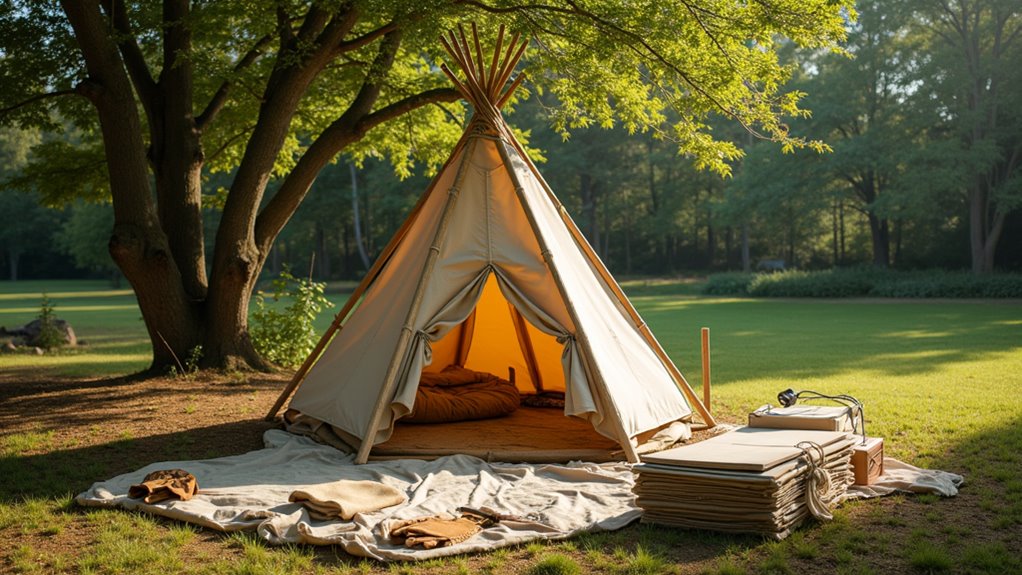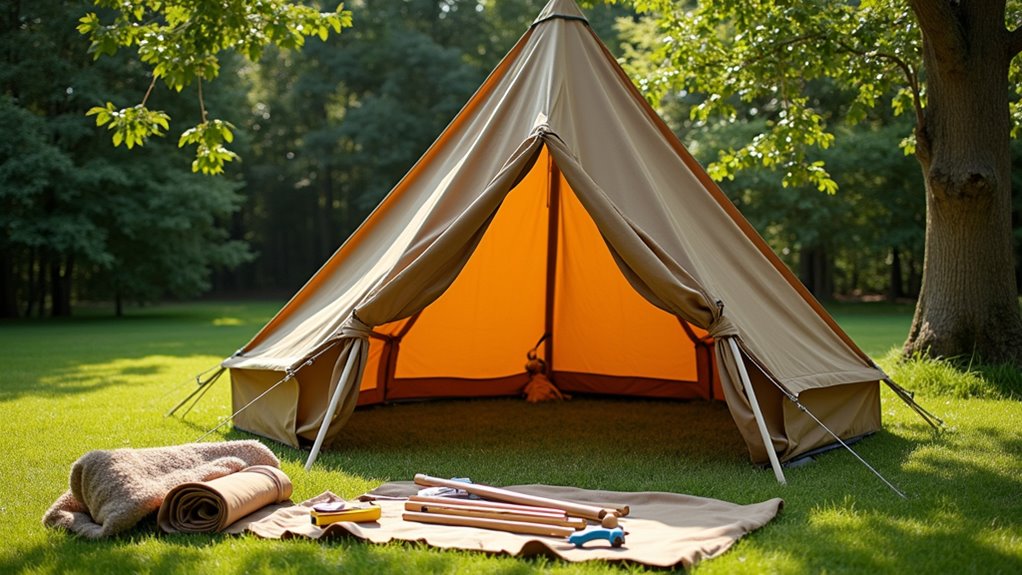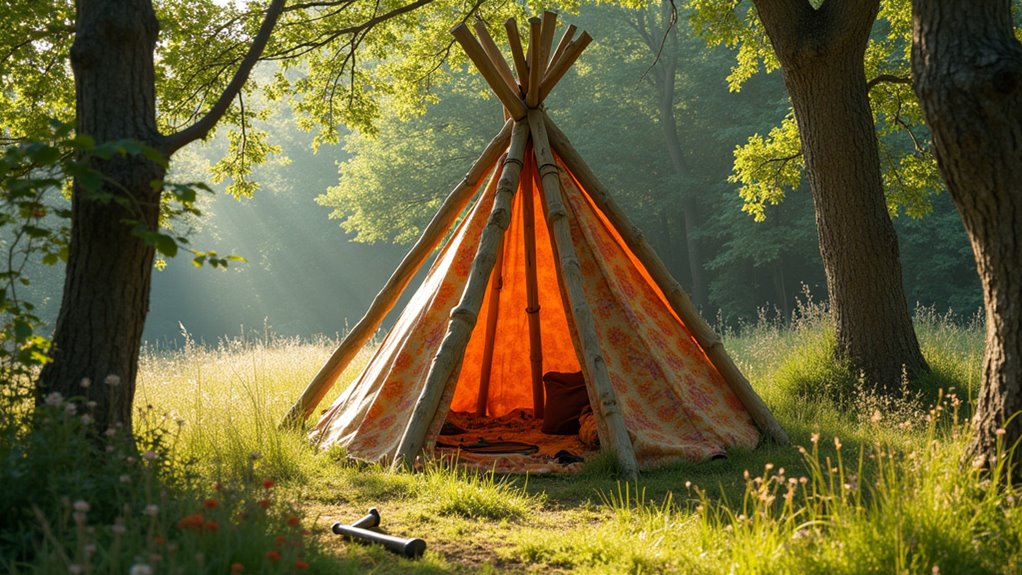How To Build Teepee Tent
This post contains affiliate links. As an Amazon Associate, we earn from qualifying purchases.
Building a teepee tent involves creating a sturdy tripod frame from strong poles, covering it with canvas fabric, and securing everything with ropes and stakes. Begin by gathering materials such as canvas fabric, poles about 12-15 feet tall, ropes, and basic tools. Then, tie three main poles together to form a tripod, add crosspieces for stability, and drape the fabric cut into 6×9 feet sections, keeping it taut with elastic strips. Secure the frame firmly with stakes and additional ropes, and regularly check the tightness of pole joints. Further details on assembly techniques and design tips will be provided later in the article for those interested in perfecting their teepee tent.
Essential Facts in 30 Seconds
- Gather essential materials: canvas fabric, long poles, ropes, saw, and drill.
- Arrange poles in a circle, lean inward, and tie securely to form a tripod frame.
- Cut and sew fabric pieces with hems and elastic strips at corners for tightness.
- Raise the frame with help, ensuring poles are symmetrical and knots are tight.
- Secure the tent to the ground with stakes and use ropes for additional support.
Materials and Tools Needed

Building a teepee tent needs several materials and tools. Canvas fabric stands strong and keeps out rain. Large tarps also work well and stop water from getting in. For cheaper options, cotton cloth or drop cloths fit indoor tents. Bivy tents are an alternative for those looking for lightweight shelter options while camping.
Fasten the fabric with lacing pins or zippers for easy door openings. Use ropes like nylon or jute to tie poles and fabric tightly. Heavy twine holds the top point firm. Ground pegs or anchors keep the teepee steady on the soil.
Basic tools include a saw, drill, and scissors. Safety gear protects your hands and eyes. Choosing the right tent material enhances comfort and protection during camping.
Picking the right materials and tools makes your teepee strong and ready for use.
Frame Construction and Pole Preparation
Building the frame of your teepee tent sets the base for strength and long use. Use long, straight poles made from pine or bamboo, about 12 to 15 feet tall. Arrange poles evenly in a circle. Lean them inward to meet at the top point. Tie the main three poles tightly together to form a strong tripod.
Here is a simple guide:
| Step | Action | Purpose |
|---|---|---|
| Pole Selection | Pick straight, strong poles | Ensures firm support |
| Binding Techniques | Tie tops with tough rope | Locks frame in place |
| Arrangement | Set poles evenly around circle | Keeps shape balanced |
| Stability Boost | Place crosspieces between poles | Adds extra strength |
This method makes your teepee sturdy and safe to use.
Fabric Preparation and Assembly

Secure the frame first.
Pick strong fabric like canvas for good weather protection. Use 300g/m² cotton for short use. Choose 420g/m² cotton-polyester for longer use. Durable fabric is essential for ensuring the longevity of your teepee tent.
Cut fabric pieces about 6 feet by 9 feet to cover the frame well. Mark the fabric center for easy alignment. Cut along the fabric weave for strength.
Sew hems with a straight stitch to stop fraying. Or use fabric tape for a no-sew edge.
Add elastic strips at corners to keep fabric tight. This prepares your teepee to stay neat and cozy in all weather. Additionally, consider the benefits of inflatable tents for a quick setup and spacious interiors if you’re looking for alternative camping options.
Assembly Process
Start building your teepee tent by picking strong poles. Use 12 to 15 poles for a 12-foot tent. Pine or bamboo works well. Make sure poles get thinner at the top.
| Action | Key Tips |
|---|---|
| Lay out poles | Make a tripod or square base |
| Check pole alignment | Keep poles even and symmetrical |
| Tie knots securely | Use clove hitch on top, figure-eight for strength |
| Raise the frame | Ask someone to help keep poles steady |
Set the base first. Then, raise the poles, keeping them straight. Place the lift pole last, at the door spot. Tighten ropes often. Check pole positions regularly to stop leaning. This keeps your teepee strong and steady.
Stability and Finishing Touches

Keep your teepee tent strong and safe. Line up all poles straight. Tie a rope around the poles halfway up. This keeps the tent tight and stops it from shaking in the wind.
Use stakes to pin the tent to the ground. This helps a lot outside. Driving stakes into the ground securely will enhance the stability of your setup, as stakes anchor tents and provide stability against wind and rain.
Add ropes from the top frame to the ground. These ropes give extra support. Clip the fabric so it doesn’t sag. Put pillows along the sides to keep them steady.
Check pole joints often to make sure they stay tight. If your teepee stays up for a short time, use heavy bases to stop it from moving in wind.
These steps make your teepee stable and fun to use.
Frequently Asked Questions
How Many People Can Comfortably Fit Inside a Teepee Tent?
A teepee tent fits 2 to 12 people comfortably. Size matters a lot here. Small teepees hold about 2 to 4 people. Larger ones can fit up to 12. Space for sleeping bags and gear is important. Bulky items take up room and reduce space for people. Plan gear placement carefully to keep comfort high. People need enough room to move and sleep well. Choose a teepee size that matches your group. This helps everyone enjoy the camping trip.
Can I Use Alternative Materials for the Frame Instead of Wood?
You can use different materials for a teepee tent frame. PVC pipes work well and are light. Furring boards offer a wood-like feel but cost less. Metal rods provide strong support and last long. Pick materials that stand up to weather and hold the tent steady. Sturdiness matters for safety and comfort outside. Choose what fits your needs and budget.
What Is the Best Location for Setting up a Teepee Tent?
Set up your teepee tent on flat ground with good drainage. Avoid low spots where water can collect. Clear the area of sharp rocks, sticks, and debris. Check the weather forecast before setting up. Strong winds and heavy rain can cause problems. Use a ground tarp for extra protection and comfort. A well-prepared site keeps your tent stable and dry. This makes camping safer and more fun.
How Do I Clean and Maintain the Fabric of the Teepee?
Clean your teepee fabric with gentle, clear detergents. Avoid strong chemicals that can damage the fabric. Brush off dirt and leaves often to keep it fresh. Let the fabric dry completely to stop mold from growing. Store the teepee in a dry place when not in use. These steps keep your teepee strong and looking good for years. Regular care saves money and effort later.
Is It Safe to Use a Fire Inside the Teepee Tent?
Using fire inside a teepee tent can be risky. Fires need air to burn safely. Good ventilation is a must to avoid smoke and carbon monoxide buildup. Keep the fire small and controlled. Always watch the flames closely. Have water or a fire extinguisher nearby. Never leave the fire unattended. Many campers use special stove pipes or fire pits made for tents. These help keep the fire safe and the tent warm. Safety first. Stay alert and enjoy your cozy camping!
Conclusion
You have built your teepee tent. It gives you a cozy, warm shelter. Perfect for cold nights or quiet moments. Check the frame often to keep it strong. Keep the fabric clean and dry to make it last. This tent is more than a shelter. It is your special place to relax and dream. Enjoy your new outdoor space. Adventure and comfort come together here.
